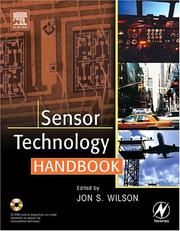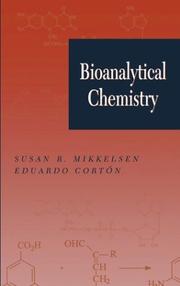| Listing 1 - 10 of 105 | << page >> |
Sort by
|
Digital
ISBN: 9780387751139 9780387751122 Year: 2008 Publisher: New York, NY Springer
Abstract | Keywords | Export | Availability | Bookmark
 Loading...
Loading...Choose an application
- Reference Manager
- EndNote
- RefWorks (Direct export to RefWorks)
Book
ISBN: 1000019341 3866445431 Year: 2010 Publisher: KIT Scientific Publishing
Abstract | Keywords | Export | Availability | Bookmark
 Loading...
Loading...Choose an application
- Reference Manager
- EndNote
- RefWorks (Direct export to RefWorks)
Im Rahmen dieser Arbeit wurden Oberflächenfunktionalisierungen für Surface Acoustic Wave (SAW) Sensoren entwickelt, die deren Anwendung im biomedizinischen Bereich ermöglichen sollten. Im Fokus der Arbeit lagen der Nachweis des Antibiotikums Penicillin G und die Konzentrationsbestimmung von zwei Proteinmarkern für Brustkrebs. Es ist gelungen Konzentrationen im unteren Nanogramm/Milliliter-Bereich dieser Verbindungen mittels der entwickelten Protokolle nachzuweisen.
Biosensoren --- Oberflächenmodifikation --- Penicillin --- SAW --- Brustkrebsmarker
Book
ISBN: 9780471118619 Year: 1998 Publisher: New York, N.Y. John Wiley & Sons, Inc.
Abstract | Keywords | Export | Availability | Bookmark
 Loading...
Loading...Choose an application
- Reference Manager
- EndNote
- RefWorks (Direct export to RefWorks)
Analytical biochemistry --- General biochemistry --- biosensoren
Book
ISBN: 9781598299113 9781598299120 Year: 2011 Publisher: [San Rafael, Calif.] Morgan & Claypool Publishers
Abstract | Keywords | Export | Availability | Bookmark
 Loading...
Loading...Choose an application
- Reference Manager
- EndNote
- RefWorks (Direct export to RefWorks)
Bacterial reporters are live, genetically engineered cells with promising application in bioanalytics. They contain genetic circuitry to produce a cellular sensing element, which detects the target compound and relays the detection to specific synthesis of so-called reporter proteins (the presence or activity of which is easy to quantify). Bioassays with bacterial reporters are a useful complement to chemical analytics because they measure biological responses rather than total chemical concentrations. Simple bacterial reporter assays may also replace more costly chemical methods as a first line sample analysis technique. Recent promising developments integrate bacterial reporter cells with microsystems to produce bacterial biosensors. This lecture presents an in-depth treatment of the synthetic biological design principles of bacterial reporters, the engineering of which started as simple recombinant DNA puzzles, but has now become a more rational approach of choosing and combining sensing, controlling and reporting DNA 'parts'. Several examples of existing bacterial reporter designs and their genetic circuitry will be illustrated. Besides the design principles, the lecture also focuses on the application principles of bacterial reporter assays. A variety of assay formats will be illustrated, and principles of quantification will be dealt with. In addition to this discussion, substantial reference material is supplied in various Annexes.
genetica --- Genetics --- biosensoren --- moleculaire biologie --- Molecular biology

ISBN: 9780750677295 141755276X 9781417552764 0080480845 9780080480848 0750677295 1281009717 9781281009715 9781601192875 1601192878 008058084X 9780080580845 Year: 2005 Publisher: Amsterdam Elsevier
Abstract | Keywords | Export | Availability | Bookmark
 Loading...
Loading...Choose an application
- Reference Manager
- EndNote
- RefWorks (Direct export to RefWorks)
Without sensors most electronic applications would not existthey perform a vital function, namely providing an interface to the real world. The importance of sensors, however, contrasts with the limited information available on them. Today's smart sensors, wireless sensors, and microtechnologies are revolutionizing sensor design and applications. This volume is an up-to-date and comprehensive sensor reference guide to be used by engineers and scientists in industry, research, and academia to help with their sensor selection and system design. It is filled with hard-to-find information, contributed by noted engineers and companies working in the field today. The book will offer guidance on selecting, specifying, and using the optimum sensor for any given application. The editor-in-chief, Jon Wilson, has years of experience in the sensor industry and leads workshops and seminars on sensor-related topics. In addition to background information on sensor technology, measurement, and data acquisition, the handbook provides detailed information on each type of sensor technology, covering: technology fundamentals sensor types, w/ advantages/disadvantages manufacturers selecting and specifying sensors applicable standards (w/ urls of related web sites) interfacing information, with hardware and software info design techniques and tips, with design examples latest and future developments The handbook also contains information on the latest MEMS and nanotechnology sensor applications. In addition, a CD-ROM will accompany the volume containing a fully searchable pdf version of the text, along with various design tools and useful software. *The only comprehensive book on sensors available! *Jam-packed with over 800 pages of techniques and tips, detailed design examples, standards, hardware and software interfacing information, and manufacturer pros/cons to help make the best sensor selection for any design *Covers sensors from A to Z- from basic technological fundamentals, to cutting-edge info. on the latest MEMS and the hottest nanotechnology applications.
Measuring methods in physics --- Electronics --- Chemical technology --- meetmethoden --- biosensoren --- sensoren

ISBN: 0471544477 Year: 2004 Publisher: Hoboken Wiley
Abstract | Keywords | Export | Availability | Bookmark
 Loading...
Loading...Choose an application
- Reference Manager
- EndNote
- RefWorks (Direct export to RefWorks)
General biochemistry --- biochemie --- biosensoren --- biochemistry --- analytische chemie --- Analytical biochemistry --- Analytical biochemistry. --- Chemistry, Analytical. --- Biochimie analytique
Book
ISBN: 9781119970873 Year: 2013 Publisher: Chichester, West Sussex : John Wiley & Sons,
Abstract | Keywords | Export | Availability | Bookmark
 Loading...
Loading...Choose an application
- Reference Manager
- EndNote
- RefWorks (Direct export to RefWorks)
Bioelectronics is a rich field of research involving the application of electronics engineering principles to biology, medicine, and the health sciences. With its interdisciplinary nature, bioelectronics spans state-of-the-art research at the interface between the life sciences, engineering and physical sciences. Introductory Bioelectronics offers a concise overview of the field and teaches the fundamentals of biochemical, biophysical, electrical, and physiological concepts relevant to bioelectronics. It is the first book to bring together these various topics, and to explain the basic theory and practical applications at an introductory level. The authors describe and contextualise the science by examining recent research and commercial applications. They also cover the design methods and forms of instrumentation that are required in the application of bioelectronics technology. The result is a unique book with the following key features: an interdisciplinary approach, which develops theory through practical examples and clinical applications, and delivers the necessary biological knowledge from an electronic engineer's perspective ; a problem section in each chapter that readers can use for self-assessment, with model answers given at the end of the book along with references to key scientific publications ; discussions of new developments in the bioelectronics and biosensors fields, such as microfluidic devices and nanotechnology. Supplying the tools to succeed, this text is the best resource for engineering and physical sciences students in bioelectronics, biomedical engineering and micro/nano-engineering. Not only that, it is also a resource for researchers without formal training in biology, who are entering PhD programmes or working on industrial projects in these areas.
Bioelectronics --- bio-elektronica --- biosensoren --- Bioélectronique --- Manuels d'enseignement --- Manuels d'enseignement. --- Electronic biology --- Biology --- Bioélectronique
Periodical
Abstract | Keywords | Export | Availability | Bookmark
 Loading...
Loading...Choose an application
- Reference Manager
- EndNote
- RefWorks (Direct export to RefWorks)
Engineering --- Health Sciences --- Life Sciences --- Biomedical Engineering --- Biotechnology --- General and Others --- General biochemistry --- biochemie --- biosensoren
Book
ISBN: 9783642314216 Year: 2012 Publisher: Berlin Heidelberg Springer Berlin Heidelberg Imprint Springer
Abstract | Keywords | Export | Availability | Bookmark
 Loading...
Loading...Choose an application
- Reference Manager
- EndNote
- RefWorks (Direct export to RefWorks)
The thesis by Mercè Pacios exploits properties of carbon nanotubes to design novel nanodevices. The prominent electrochemical properties of carbon nanotubes are used to design diverse electrode configurations. In combination with the chemical properties and (bio)functionalization versatility, these materials prove to be very appropriate for the development of electrochemical biosensors. Furthermore, this work also evaluates the semiconductor character of carbon nanotubes (CNT) for sensor technology by using a field effect transistor configuration (FET). The CNT-FET device has been optimized for operating in liquid environments. These electrochemical and electronic CNT devices are highly promising for biomolecule sensing and for the monitoring of biological processes, which can in the future lead to applications for rapid and simple diagnostics in fields such as biotechnology, clinical and environmental research.
Electrochemistry --- Chemical structure --- Analytical chemistry --- Chemistry --- Electrical engineering --- moleculen --- nanotechniek --- biosensoren --- analytische chemie --- chemie --- atomen --- elektrochemie
Book
ISBN: 0471186163 Year: 1996 Publisher: Weinheim Wiley-VCH
Abstract | Keywords | Export | Availability | Bookmark
 Loading...
Loading...Choose an application
- Reference Manager
- EndNote
- RefWorks (Direct export to RefWorks)
"Fundamentals of Food Biotechnology" details the developments in biotechnology related to food production and processing, including new applications involving food ingredient processing, plant tissue cultures, and genetic engineering. The text successfully translates the basic scientific information of food-related biotechnology into industrial and research applications. The initial chapters provide tutorials reviewing the principles of biochemistry, microbiology, and biochemistry engineering to provide the fundamental knowledge required to comprehend biotechnology. The second section of this textbook explains how different biotechnology processes and products are applied to food products. The concluding chapters describe new and potential applications of biotechnology in plants and animals, in devising biosensors for detecting microorganisms and otherwise monitoring food quality, in waste management and food processing, and in food safety. Each chapter contains problems with solutions as well as extensive references to provide avenues for future studies. "Fundamentals of Food Biotechnology" also includes a glossary of important terminology to facilitate learning.
General biochemistry --- Biotechnology --- Food science and technology --- voedingsmiddelenindustrie --- voedingschemie --- voedingstechnologie --- biosensoren --- biochemie --- biotechnologie
| Listing 1 - 10 of 105 | << page >> |
Sort by
|

 Search
Search Feedback
Feedback About UniCat
About UniCat  Help
Help News
News